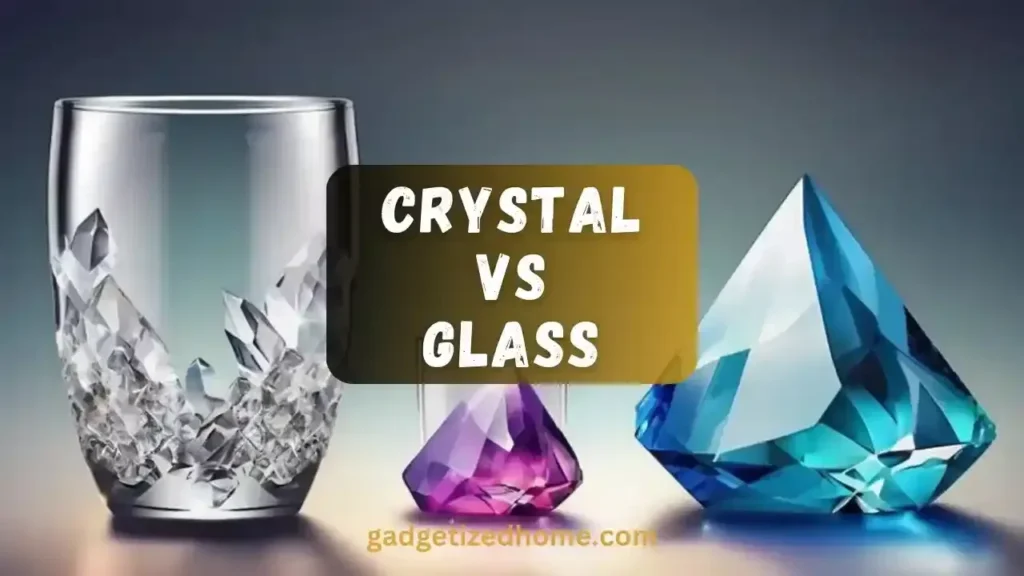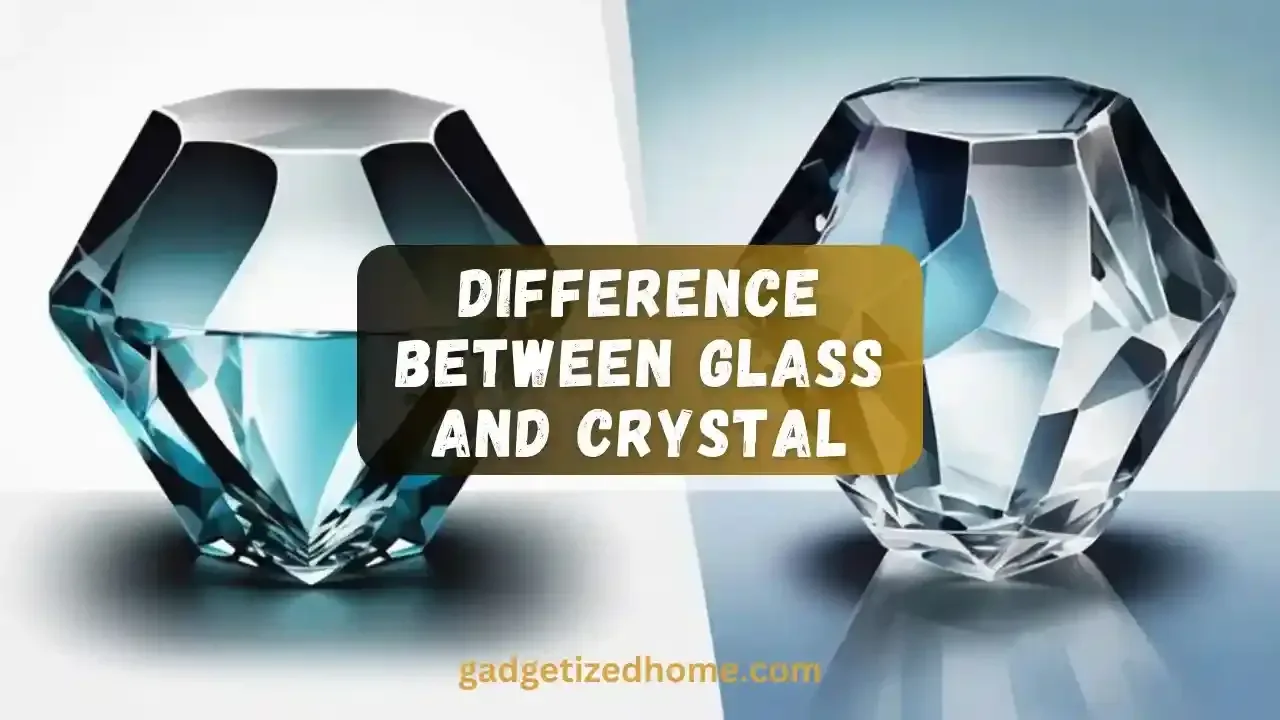If you’ve ever wondered, what is the difference between glass and crystal, you’re not alone. Many people find it confusing to tell them apart, especially when shopping for home décor or drinkware.
Understanding the difference between glass and crystal can help you make better choices. Whether it’s for chandeliers, vases, or wine glasses, knowing what sets them apart is important.
In this guide, we’ll break down the key aspects of crystal vs glass. From how they’re made to how they look and feel, we’ll cover everything you need to know.
Composition and Manufacturing Process
When comparing glass vs crystal, the main difference lies in their composition. Glass is created by heating a mixture of sand, soda ash, and limestone at high temperatures until they melt together. It’s a basic and versatile material used in many everyday items.
Crystal, on the other hand, has a slightly different makeup. The difference between glass and crystal is that crystal contains lead, often up to 24%, which gives it its signature sparkle. The lead content also makes crystal heavier and more reflective than regular glass.
The manufacturing process for crystals requires more precision. The higher lead content allows it to be cut and shaped with finer details, making crystal ideal for decorative items like chandeliers and high-end glassware. Glass, being more durable and less expensive, is used for items like windows, bottles, and everyday drinkware.
Appearance and Aesthetics
When deciding between crystal or glass, appearance plays a major role. Crystal is known for its brilliance and clarity, thanks to the lead content that enhances its ability to reflect light. This gives the crystal its iconic sparkle, making it a popular choice for chandeliers and fine glassware.
Glass vs crystal glass differs in how they catch the light. Crystal glass, with its lead content, has a more luxurious shine compared to regular glass, which appears duller in comparison. The lead in the crystal also makes it feel heavier and more premium.
When you compare glass versus crystal, you’ll notice that crystal has more intricate designs due to its softness, allowing for detailed cuts and shapes. Regular glass, though more durable, is less reflective and often has simpler designs, making it better for everyday use.
Crystal Glass vs Crystal vs Glass

Understanding crystal glass vs glass can be tricky since both can look similar at first glance. Regular glass is lead-free, making it durable and ideal for daily use, like in windows and drinkware. It’s clear but lacks the sparkle of crystal.
Crystal vs crystal glass is another point of confusion. Crystal typically contains a higher percentage of lead, giving it a heavier feel and brilliant shine. Crystal glass, however, has less lead or none at all, so it’s lighter but still has some sparkle compared to standard glass.
When comparing crystalline glass vs glass, crystalline glass is a mid-point. It’s sturdier than traditional crystal due to its lower lead content but retains some of the shine and weight that make crystal attractive. This makes it a great balance between durability and elegance.
Uses and Applications
When discussing crystal vs glass, it’s essential to consider their applications. Both materials serve different purposes based on their properties and aesthetics. Here’s how they stack up:
- Crystal: Known for its elegance, crystal is often used in high-end items. It’s popular for:
- Fine drinkware, like wine glasses and decanters
- Decorative pieces, including vases and sculptures
- Lighting fixtures, such as crystal chandeliers, where its sparkle enhances the ambiance
- Glass: More versatile and durable, glass is commonly used in everyday items. It’s ideal for:
- Windows and doors provide protection and visibility
- Drinkware, including tumblers and beer glasses, designed for frequent use
- Kitchenware and storage containers, where durability is key
The choice between glass vs crystal often comes down to the occasion. For special events, crystal elevates the experience, while glass offers practicality for daily needs. Understanding the uses of each can help you decide which material is best for your needs.
Looking for stunning lighting options? Check out our recommendations for the 7 Best Dining Room Chandeliers to elevate your dining experience!
Durability and Maintenance
When comparing glass vs crystal, durability is a key factor. Regular glass is generally more resilient, making it less prone to chipping and breaking. This durability makes glass ideal for everyday use, especially in homes with children or pets.
In contrast, crystal, while beautiful, is more delicate. Its intricate designs and higher lead content make it susceptible to scratches and chips. This means that while crystal enhances special occasions with its elegance, it requires more careful handling and maintenance.
When discussing glass versus crystal, maintenance also differs significantly. Glass items can often be cleaned in the dishwasher, making them convenient for busy households. However, crystal requires more gentle cleaning methods, often needing handwashing to preserve its shine and intricate details.
Understanding these aspects can help you choose the right material for your needs. If you prioritize durability and ease of care, glass is the better option. But if you want to impress guests with elegance, crystal is worth the extra attention.
Cost Comparison
When it comes to cost, glass vs crystal shows a clear difference. Glass is typically more affordable due to its simpler manufacturing process and wide availability. This makes it the go-to option for everyday items like drinkware, windows, and storage containers.
Crystal, however, is more expensive. The higher lead content, skilled craftsmanship, and brilliance of Crystal drive up its price. Items like crystal chandeliers or fine glassware can be significantly more costly compared to regular glass.
The choice between glass versus crystal often comes down to budget and purpose. If you’re looking for affordable, practical options, glass is the better choice. For special occasions or adding a touch of luxury to your home, the extra cost of crystal may be worth it.
For those on a low budget, check out our blog post on the 8 Best Cheap Chandeliers Under $100 for affordable yet stylish options.
Environmental Impact
When comparing the environmental impact of glass vs crystal, glass tends to be the more eco-friendly option. Regular glass is recyclable and can be reused multiple times without losing quality. Its production process also generally has a lower environmental footprint compared to crystal.
Crystal, especially leaded crystal, poses more environmental concerns. The manufacturing process for crystals requires more energy and involves lead, a toxic substance that can harm the environment if not properly managed. Recycling crystals is also more challenging due to their lead content, making them less sustainable.
In the debate of glass versus crystal, if eco-friendliness is a priority, glass is the clear winner. It’s easier to recycle and has less impact on the environment during production. Crystal, while beautiful, comes with a higher environmental cost.
Conclusion
In summary, understanding the difference between glass and crystal can help you make more informed decisions when selecting items for your home. From the composition to the appearance, durability, and cost, each material offers unique benefits depending on your needs.
Whether you prioritize the elegance of crystal or the practicality of glass, both have their place in modern homes. Glass is more durable and eco-friendly, while crystal adds a touch of luxury with its sparkle and craftsmanship.
Thank you for reading this guide and exploring the differences between crystal and glass. We hope it provides valuable insights to help you make an informed decision!
Recent Posts
- 10 Best Nesting Tables for Small Spaces and Apartments
- 10 Best Ladder Bookshelves for Stylish Home Organization
- 9 Best Storage Trunks for Home Organization and Style
- 10 Best Room Dividers for Privacy and Stylish Spaces
- 11 Best Bar Carts for Entertaining Guests in Style
- 10 Best Decorative Accent Cabinets for Stylish Home Storage
- 9 Best Convertible Futons and Sofa Beds for Small Apartments
- 10 Best Modular Furniture Sets for Flexible and Functional Living
- 10 Best Cube Storage Units for Organized and Stylish Homes
- 9 Best Closet Organizer Systems for Maximizing Your Space
- 10 Best Murphy Beds and Wall Beds for Small Guest Rooms
- 15 Best Folding Furniture Pieces for Small Apartments and Studios
- 12 Best Storage Ottomans for Small Spaces and Apartment Living
- 9 Best Activity Tables for Kids for Fun and Learning
- 9 Best Kids’ Dressers for Organized Bedrooms
Our Main Categories
Ceiling Lights
- Chandeliers
- Wheel Chandeliers
- Pendant Lights
- Flush Mount Lights
- Track Lights
- Recessed Lights
- Semi Flush Mount Lights
- Cove Lights
Ceiling Fans with Lights
- Indoor Ceiling Fans
- Outdoor Ceiling Fans
- Ceiling Fans Light Kits
- Ceiling Fans Accessories
Wall Lighting
- Flush Mount Wall Lighting
- Wall Sconces
- Night Lighting
- Picture Lights
- Swing Arm Lights
- Step Lights
- Hall Lights
- Swing Arm Lamps
Outdoor Lighting
- Outdoor Wall Lights
- Outdoor Ceiling Lights
- Landscape Lighting
- String Lights
- Post Lights
- Motion Sensor Lights
- Dusk to Dawn Lights
- Lanterns
- Garden Lights
- Barn Lights
Lamps and Lamp Shades
- Table Lamps
- Floor Lamps
- Lamp Sets
- Desk Lamps
- Reading Lights
- Book lights
- LED Lamps
- Lamp Shades
Kitchen Lights
- Kitchen Island Lights
- Under Cabinet Lights
- Over Sink Lighting
- Under Cabinet Strip Lights
- Inside Cabinet Lights
Bathroom Lighting
- Bathroom Vanity Lights
- Bathroom Sconces
Special Lights
- Smart Bulbs
- Energy Efficient Lights
- Christmas Lights
- Festive String Lights
- Solar Lights
















